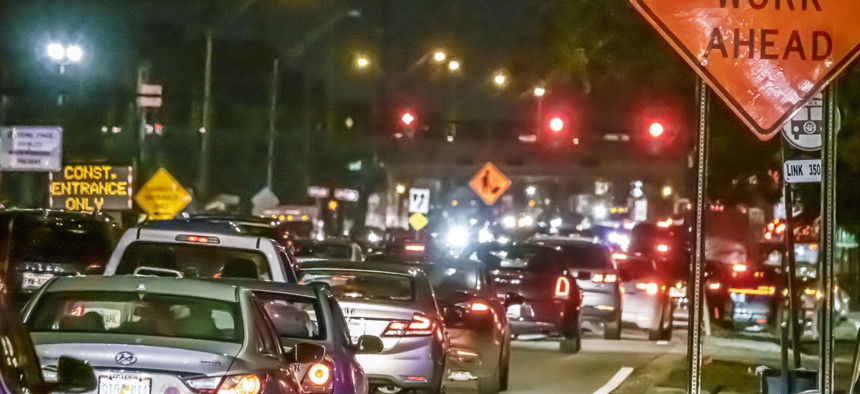Work Zones Cause Crashes—but Only Sometimes

Slow moving traffic in a construction zone in Orlando. Jeffrey Greenberg/UCG/Universal Images Group via Getty Images
Researchers found that there are more vehicle accidents in work zones on busy roads, among other things.
Road construction zones are a headache for drivers and a hazard for workers, but, when it comes to safety, a new study suggests the likelihood of crashes increases when the work zones are long, the roads are busy, and the time is during daylight hours.
The study by a team of researchers from Carnegie Mellon University, which was published in the journal Analytic Methods in Accident Research, provided new insights into a common problem for transportation agencies, said Sean Qian, one of the study’s authors and a professor of civil and environmental engineering at Carnegie Mellon University in Pittsburgh.
For years, he explained, transportation officials have observed that crashes increase in road construction zones. That would make sense given the amount of disruption that work zones cause, including new traffic patterns, narrower lanes and the nearby construction activity.
Researchers who tried to explain what was happening, though, had limited tools at their disposal. Most of them showed that crashes tended to increase at the same times construction zones were put in place. But others found that the likelihood of crashes decreased in construction zones, likely because vehicles were hemmed in by slower-moving trucks or cars for miles on end, Qian said.
Part of the confusion was that researchers didn’t know whether work zones actually caused the crashes, or whether something else was at play.
Qian teamed up with Burcu Akinci, another professor of civil and environmental engineering, and Zhuoran Zhang, a research assistant, to look at the problem. The team concluded that the work zones did, in fact, cause more crashes–but only in certain circumstances.
The Carnegie Mellon researchers looked at three years’ worth of crash data from Pennsylvania roads to arrive at the conclusion.
They tried to rule out other factors that could cause increases in work zone crashes. So, for example, they only looked at work zones that lasted a short time. That made the before-and-after analysis easier, because underlying conditions would not have changed much. If they included work zones that had been in place for months or years, everything from weather to driving patterns could have changed in the interim.
The team also took into account the speed of traffic and weather conditions at the times of the crashes.
Some Surprises
One conclusion the researchers reached was that the work zones caused significantly more crashes on busy roads–those with more than 20,000 vehicles a day–but not for lower-volume roads.
But crashes even on high-volume roads did not increase significantly for shorter work zones (less than 3,000 meters, or almost two miles).
“Holding everything else the same, a shorter work zone would be desired to reduce the crash risk on high traffic volume roadways,” the researchers found.
The increase in crashes was also not significant on those roads at night, they found. Qian noted in an interview with Route Fifty that traffic on roads is measured in vehicles per day, but often the stream of vehicles decreases at night.
“This really implies that PennDOT did a great job with their nighttime configurations,” he said.
“This is very different,” Qian cautioned, “than saying that we should move all the work from the daytime to the nighttime.”
In the end, transportation agencies must weigh many factors about when to roll out work zones, including the overall cost and the availability of contractors, he said.
“For any safety analysis, we’re talking about a rare event. It’s very, very unlikely, but the consequences are potentially fatal,” he said. “How do you make the decision of how to deploy the work zone? We don’t have a solution for it in this one single paper, but we are providing additional numbers for state agencies to consider when they make a decision.”
Daniel C. Vock is a senior reporter for Route Fifty based in Washington, D.C.
NEXT STORY: Smart edge infrastructure expands capacity, real-time data access






